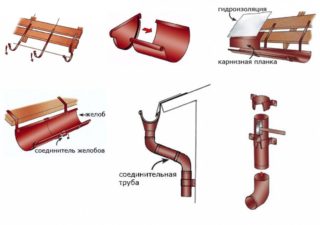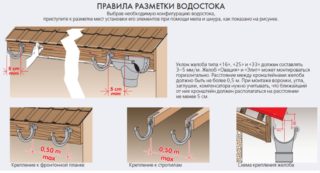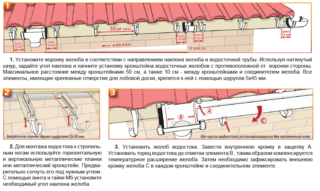A high-quality drainage system prevents the destruction of the building frame under the influence of moisture. With proper installation of trays, funnels, pipes, they serve 15 or more years. More often, craftsmen prefer to install a plastic drainage system. The polymer is lighter, which means that it does not exert a significant load on the frame of the roof and the house. In addition, plastic systems are sold in a wide variety of colors, you can choose one to one color with the roofing material.
Installation rules for plastic drainage systems

When installing all communication elements, it is important to be guided by the following rules:
- Work on a polymer drainage device is carried out at a temperature of +5 degrees. It is prohibited to carry out installation in minus indicators. The plastic becomes brittle and can burst under force.
- Fastening brackets with even pitch. Hooks for polymeric gutters can be positioned at a distance of 60-80 cm, depending on their section. The larger it is, the smaller the distance between the holders is made. In this case, first, the extreme brackets are fixed at a distance of 10-15 cm from the beginning of the frontal board. Already between them, the remaining hooks are installed with an equal pitch.
- Compliance with the slope. When installing a plastic drainage system, a slope should be made towards the receiving funnel. Experts recommend sticking to a value of 3-5 mm for each meter of trays.
- Using the "right" tool. For polymer, metal scissors and a hacksaw are often used. For high-quality cleaning of the edges, it is better to use emery.
- Docking of trays is carried out using seals, latches / clamps or glue.
- The downpipe is attached to the wall with clamps. The distance from the building box to the tube should be at least 6-8 cm.
During installation work, it is necessary to ensure that the roof slope protrudes 1/2 or 1/3 of the bend of the gutter. This will prevent the entire mass of the snow layer from settling on it.
Installation tools
The wizard to install the drainage system will need the following tools:
- construction pencil;
- tape measure or ruler;
- control cord;
- nails and screws / screws;
- hacksaw for metal;
- emery or file;
- scissors for metal;
- hammer, screwdriver.
It is also necessary to prepare the required number of water intake trays, funnels, pipes and transitional elbows for it.
Installation steps
- Markup. Determine where the downpipe and hooks are to be attached. The control cord is pre-installed.
- Attach brackets for trays. Fixed depending on the configuration. Long ones are attached to roof rafters. Short - to the frontal board. Be sure to observe the slope along the previously placed control cord.
- In the extreme tray, which will be connected to the funnel, a hole is made for it. The two elements are joined and installed on the brackets.
- From this tray, the installation of the rest begins, monitoring the tightness of the joints.
- Caps are installed along the edges of the mounted gutters.
Last of all, from the funnel downward, collect the drainpipe. All bends in the area of the foundation or protrusions of the building box are bypassed using elbows.
How to avoid installation errors
- Incorrect determination of the capacity of the gutters and funnels.As a result, the system will not cope with the volume of storm water and will overflow it. All calculations are carried out at the roof design stage. It is important to take into account the area of the slopes, their angle of inclination, the type of roofing and the average annual precipitation in the region.
- No slope of trays towards the funnel. If the gutters are positioned exactly horizontally, the water will stand in the gutters and simply flow over the edge. In cold weather, this will lead to icing and further breakage of the system under the weight of the ice.
- Installation of gutters with an inclination towards the wall of the house or away from it. The water will also overflow.
- Incorrect overhang of the slope over the trays. If it occupies more than 1/2 of the width of the gutter, the rate of outflow of water from the roof will not allow it to fully enter the trays. Again, the drains will overflow.
- The downpipe is too close to the wall of the house. Firstly, this can lead to vibration of the element against the box of the building. Secondly, it is possible that the walls of the house will get wet when the rainwater is outflowing.
Taking into account possible bloopers in work and observing all the installation rules, the master can quickly assemble a drain from polyvinyl chloride and ensure its long-term further operation.










